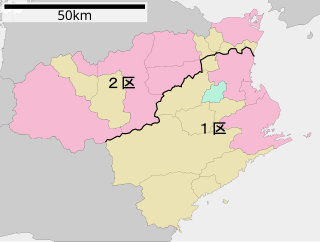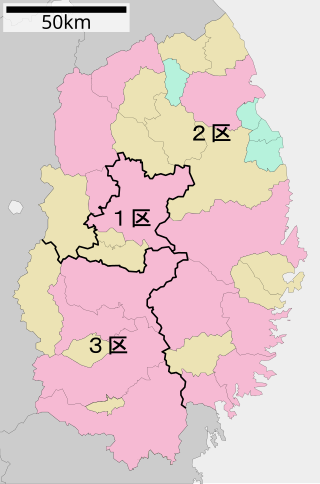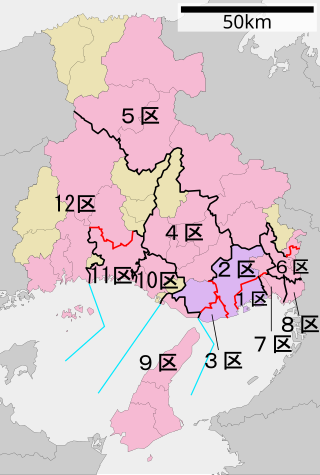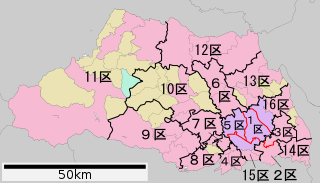Related Research Articles

Kanagawa 11th district is a constituency of the House of Representatives in the Diet of Japan. It is located in Kanagawa Prefecture, and consists of the cities of Miura and Yokosuka. Former Prime Minister of Japan Junichiro Koizumi served as the first representative of the constituency from its creation in 1996. Koizumi retired at the 2009 elections and his son Shinjirō ran as a candidate for his father's old seat. The Democratic Party of Japan fielded Katsuhito Yokokume, a lawyer and former participant in the Ainori TV show, as a candidate in 2009 to a bid to end the LDP dominance of the district.

Tokushima 1st district (徳島県第1区) is a constituency of the House of Representatives in the Diet of Japan, located in Tokushima Prefecture on the island of Shikoku.

Gunma 1st Districtis a single-member constituency of the Japanese House of Representatives, the lower house of the National Diet. It is located in Gunma Prefecture and consists of the cities of Maebashi and Numata and the district of Tone as well as parts of the cities of Kiryū, Shibukawa and Midori. As of 2012, 387,120 eligible voters were registered in the district.

Gunma 5th district is a constituency of the House of Representatives in the Diet of Japan. It is located in Gunma Prefecture and consists of the cities of Tomioka, Annaka, parts of Takasaki and Shibukawa as well as the Kitagunma, Kanra and Agatsuma districts. As of 2012, 315,747 eligible voters were registered in the district.

Hokkaidō 9th district is a constituency of the House of Representatives in the Diet of Japan. It consists of Hokkaido's Hidaka and Iburi Subprefectures. As of 2009, 414,438 eligible voters were registered in the district.
Wakayama 3rd district is a constituency of the House of Representatives in the Diet of Japan. It is located in Wakayama Prefecture and consists of Arida, Gobo, Shingu, and Tanabe cities and the Arida, Hidaka, Higashimuro, and Nishimuro districts. As of 2012, 298,296 eligible voters were registered in the district.

The Tokyo 3rd district is a constituency of the House of Representatives in the Diet of Japan. It is located in Tokyo and covers parts of the former city of Tokyo and Tokyo's outlying islands. The district consists of the wards of Shinagawa and parts of Ōta, the towns of Ōshima and Hachijō and the villages of Toshima, Niijima, Kōzushima, Miyake, Mikurajima, Aogashima and Ogasawara. As of 2012, 482,494 eligible voters were registered in the district.

Tokyo 1st district is a constituency of the House of Representatives in the Diet of Japan. It is located in eastern mainland Tokyo and covers central parts of the former city of Tokyo. The district consists of the wards of Chiyoda, Minato and Shinjuku. As of 2016, 514,974 eligible voters were registered in the district. After redistricting in 2017, a part of Shinjuku was moved to the Tokyo 10th district and a part of Minato was moved to the Tokyo 2nd district.

Iwate 4th district was a constituency of the House of Representatives in the Diet of Japan. It was located in southwestern Iwate and consisted of the cities of Hanamaki, Kitakami and Ōshū as well as the Waga and Isawa Districts. As of 2012, 305,917 eligible voters were registered in the district.

Aichi 6th district is a constituency of the House of Representatives in the Diet of Japan. It is located in Aichi and consists of the cities of Seto and Kasugai. The cities are just north of Nagoya and a part of the Chūkyō Metropolitan Area. Before the 2022 redistricting, the 6th consisted of Kasugai, Inuyama and Komaki. As of 2012, 420,807 eligible voters were registered in the district.

Chiba 4th district is a constituency of the House of Representatives in the Diet of Japan. It is located in the city of Funabashi in Western Chiba. As of 2016, 459,431 eligible voters were registered in the district. In the 2009 and 2012 general elections, the district had the lowest electoral weight throughout Japan at more than two times as many voters as the district with the highest electoral weight, Kōchi-3rd.
Nagasaki 2nd district is a constituency of the House of Representatives in the Diet of Japan. It is located in Southern Nagasaki and covers parts of the city of Nagasaki, the cities of Shimabara, Isahaya, Saikai, Unzen and Minamishimabara as well as the Nishisonogi District with the towns of Togitsu and Nagayo. As of 2009, 335,195 eligible voters were registered in the district.
Hiroshima 7th District is a constituency of the House of Representatives in the Diet of Japan. It is located in Hiroshima and consists of the city of Fukuyama. As of 2012, 377,672 eligible voters were registered in the district.

Hyogo 11th district is a constituency of the House of Representatives in the Diet of Japan. It is located in Southwestern Hyōgo and is based on the 1995 borders of the city of Himeji; the former towns of Ieshima, Yumesaki, Kōdera and Yasutomi that merged into Himeji in 2006 are part of the 12th district. As of September 2015, 387,509 eligible voters were registered in the district.

Saitama 3rd district is a constituency of the House of Representatives in the Diet of Japan. It is located in Southeastern Saitama and consists of the cities of Sōka and Koshigaya. As of 2012, 460,884 eligible voters were registered in the district.

Fukuoka 8th district is a single-member constituency of the House of Representatives in the Diet of Japan. It covers Northern central parts of Fukuoka including the city of Iizuka, home to the Asō family and Tarō Asō, Liberal Democratic Party (LDP) faction leader and the only representative for the 8th district since its creation. He was elected LDP president in 2008 against Kaoru Yosano and three other candidates, but resigned one year later following the most devastating general election result in party history – his successor would be the second LDP president in history not to become prime minister after his election. Yet, Asō carried his own district by an overwhelming margin in 2009.

Shiga 1st district is a single-member constituency of the House of Representatives, the lower house of the national Diet of Japan. It is located in Western Shiga and covers the cities of Ōtsu, the prefectural capital, and Takashima. As of 2009, 314,742 eligible voters were registered in the district.

Ishikawa 2nd district is a single-member constituency of the House of Representatives, the lower house of the national Diet of Japan. It is located in Southern Ishikawa Prefecture and covers the cities of Komatsu, Kaga, Nomi, Hakusan, Nonoichi and the town of Kawakita.
Ōsaka 12th district is a single-member electoral district for the House of Representatives, the lower house of the National Diet of Japan. It is located in North-eastern Osaka and covers the cities of Neyagawa, Daitō and Shijōnawate. As of September 2012, 342,226 voters were registered district, giving its voters slightly above average vote weight.

Yamaguchi 4th district is a single-member electoral district for the House of Representatives, the lower house of the National Diet of Japan. It is located in Western Yamaguchi and consists of the cities of Shimonoseki and Nagato. The seat was held by former Prime Minister of Japan Shinzo Abe until his assassination in July 2022. As of September 2011, 266,456 voters were registered in the district, giving its voters well above average vote weight. Unlike many prefectures where the capital is also the most populous city, Yamaguchi's major city is Shimonoseki, located at the western tip of Honshū and adjacent to Kyushu island's Fukuoka-Kitakyūshū metropolitan area which lies just south across the Kanmon Straits.
References
- ↑ Ministry of Internal Affairs and Communications (MIC): 平成24年9月2日現在選挙人名簿及び在外選挙人名簿登録者数>選挙区ごとの選挙人名簿及び在外選挙人名簿登録者数等 (in Japanese)
- ↑ The Japan Times, June 27, 2003: Sakai, cohort plead not guilty to defrauding state
- ↑ The Japan Times, March 23, 2007: Prosecutors drive ex-labor minister to penitentiary
- ↑ 総選挙2012>開票結果 小選挙区 佐賀. Yomiuri Shimbun (in Japanese). Retrieved 2013-06-05.
- ↑ 衆議院>第45回衆議院議員選挙>佐賀県>佐賀1区. ザ・選挙 (in Japanese). JANJAN. Archived from the original on 2010-01-11. Retrieved 2010-01-07.
{{cite web}}: External link in|work= - ↑ 衆議院>第44回衆議院議員選挙>佐賀県>佐賀1区. ザ・選挙 (in Japanese). JANJAN. Archived from the original on 2009-08-22. Retrieved 2009-12-30.
{{cite web}}: External link in|work= - ↑ 衆議院 >第43回衆議院議員選挙 >佐賀県>佐賀1区. ザ・選挙 (in Japanese). JANJAN . Retrieved 2009-12-30.
{{cite web}}: External link in|work= - ↑ 衆議院>第42回衆議院議員選挙>佐賀県>佐賀1区. ザ・選挙 (in Japanese). JANJAN . Retrieved 2009-12-30.
{{cite web}}: External link in|work= - ↑ 衆議院>第41回衆議院議員選挙 >佐賀県>佐賀1区. ザ・選挙 (in Japanese). JANJAN . Retrieved 2010-01-07.
{{cite web}}: External link in|work=